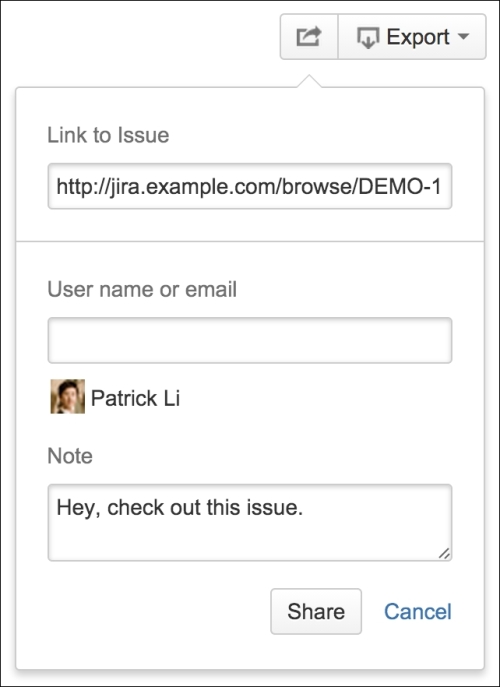As we have seen, issues are the center of JIRA. In the following sections, we will look at what you, as a user, can do with issues. Note that each of the actions will require you to have specific permissions, which we will cover in Chapter 8, Securing JIRA.
When creating a new issue, you will need to fill in a number of fields. Some fields are mandatory, such as the issue's summary and type, while others are optional, such as the issue's description. We will discuss fields in more details in the next chapter.
There are several ways in which you can create a new issue in JIRA. You can choose any of the following options:
- Click on the Create button at the top of the screen.
- Press C on your keyboard.
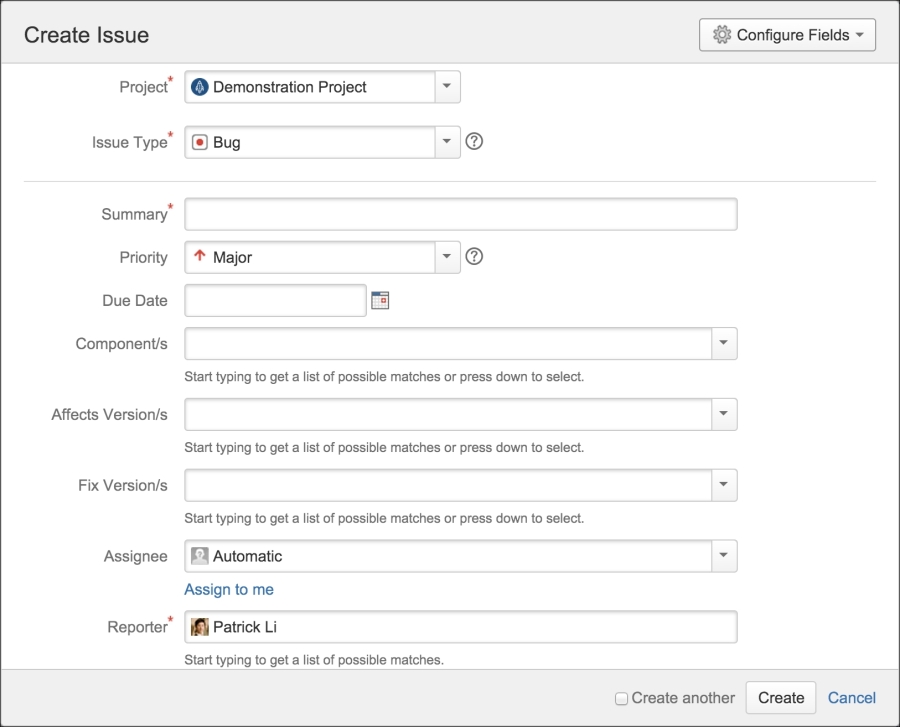
This will bring up the Create Issue dialog box, as shown in the preceding screenshot. As you can see, there are quite a few fields, and the required fields will have a red asterisk (*) mark next to their names.
The administrator configures what fields will be part of the create dialog, but as a user, you can customize and make your own create screen by hiding the optional fields, by performing the following steps:
- Click on the Configure Fields option at the top-right corner.
- Select the Custom option.
- Uncheck all the fields you want to hide, and check the fields that you want to show.
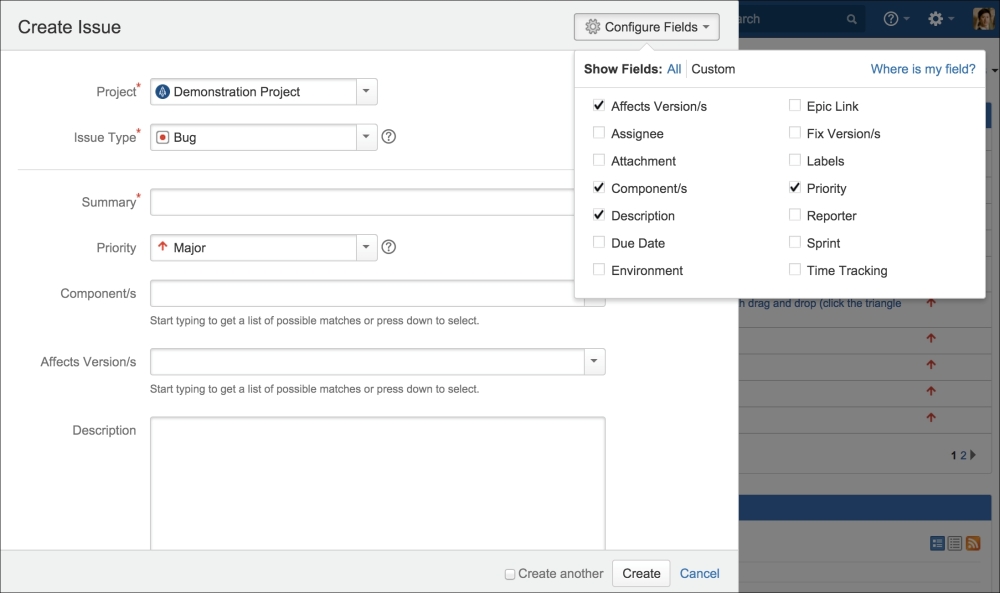
There is a Create another option beside the Create button. By ticking this option and then clicking on the Create button, the Create Issue dialog box will stay on the screen and remember the values you have previously entered, such as priority, components, and due dates. This way, you can avoid having to fill in the whole dialog box again and will only have to update some of the fields that actually are different, such as Summary. With this feature, you can rapidly create many issues in a much shorter time frame.
There are two ways in which you can edit an issue in JIRA. The first and more traditional way is by clicking the Edit button or pressing E on your keyboard. This will bring up the Edit Issue dialog with all the editable fields for the current issue. This allows you to make changes to multiple fields at once.
The second option is called in-line editing. With this feature, you will be able to view the issue and edit the field you want on the spot, without having to wait for the edit dialog to load. Scroll down to find the field. To edit a field in-line, all you have to do is hover your mouse over the value for the field you want to update, wait for the Edit icon to show up, click the icon, and start editing.
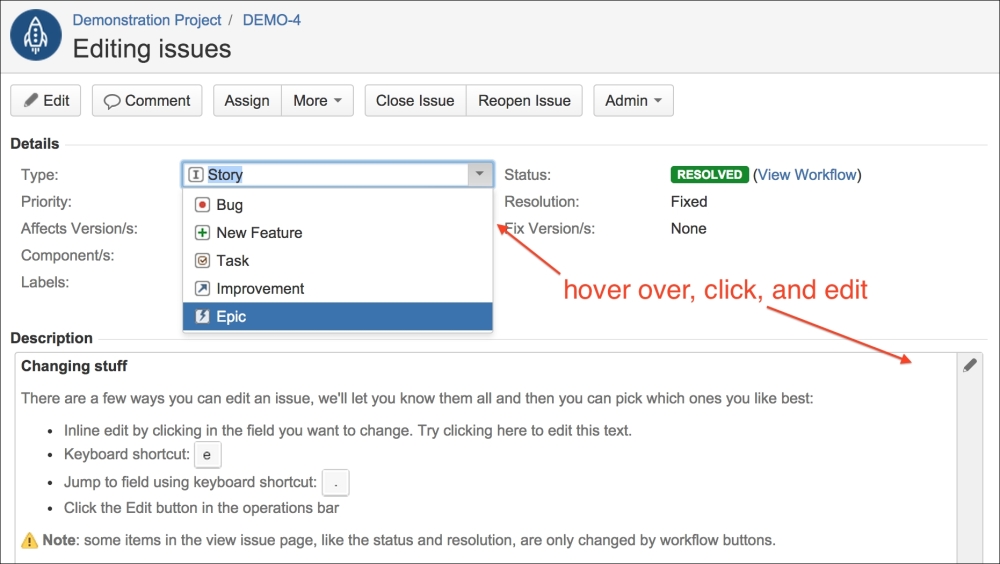
You can delete issues from JIRA. You might need to delete issues that have been created by mistake or if the issue is redundant, although normally, it is better to close and mark the issue as a duplicate. We will discuss closing an issue in Chapter 6, Workflows and Business Processes.
Perform the following steps to delete an issue:
- Browse to the issue you wish to delete.
- Click on the Delete option from the More menu. This will bring up the Delete Issue dialog box.
- Click on the Delete button to remove the issue permanently from JIRA.
Deleting an issue permanently removes it from JIRA, along with all of its data including attachments and comments.
Once an issue has been created, the issue is associated with a project. You can, however, move the issue around from one project to another. This may sound like a very simple process, but there are many steps involved and things to be considered.
First, you need to decide on a new issue type for the issue, if the current issue type does not exist in the new project. Second, you will need to map a status of the issue. Third, you will need to decide on the values for the fields that exist in the new project but which do not exist in the current project if those fields are set to mandatory in the new project. Sounds like a lot? Luckily, JIRA comes with a wizard that is designed to help you address all those items.
Perform the following steps to start moving an issue:
- Browse to the issue you wish to move.
- Click on the Move option in the More menu. This will bring up the Move Issue wizard.
There are essentially four steps in the Move Issue wizard.
The first step is to select which project you wish to move the issue to. You will also need to select the new issue type. If the same issue type exists in the new project, you can usually continue to use the same issue type.
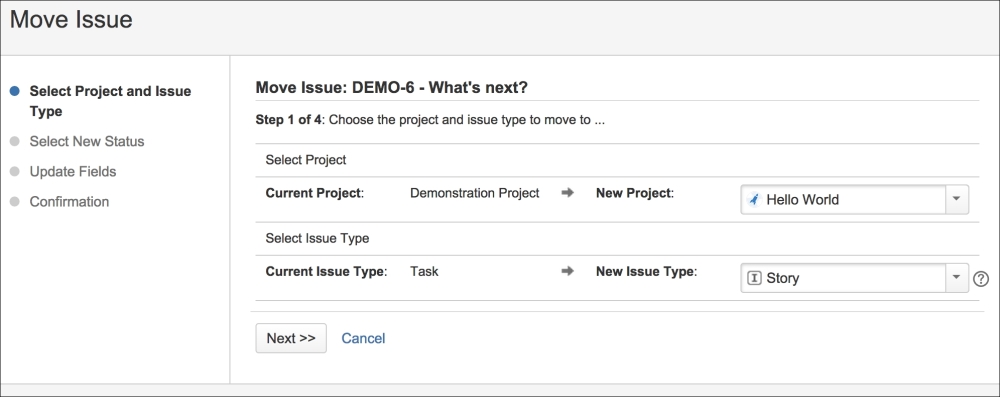
The second step allows you to map the current issue to the new project's workflow. If the issue's status exists in the target project, the wizard will skip this step.
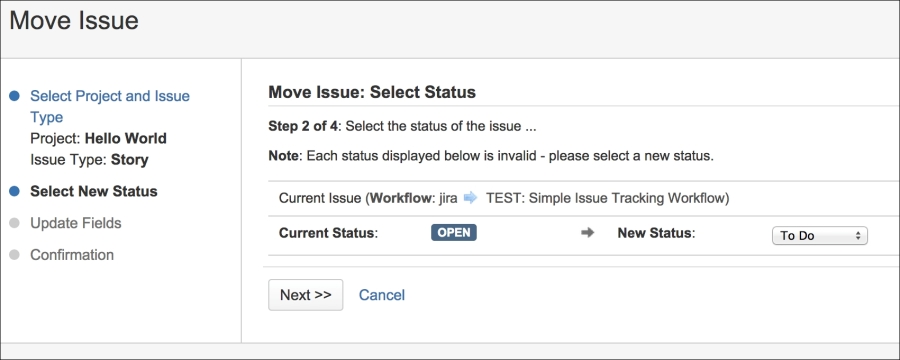
The third step shows all the fields that exist in the new project but not the current project and which require a value. Again, if there are no missing fields, this step will be skipped.
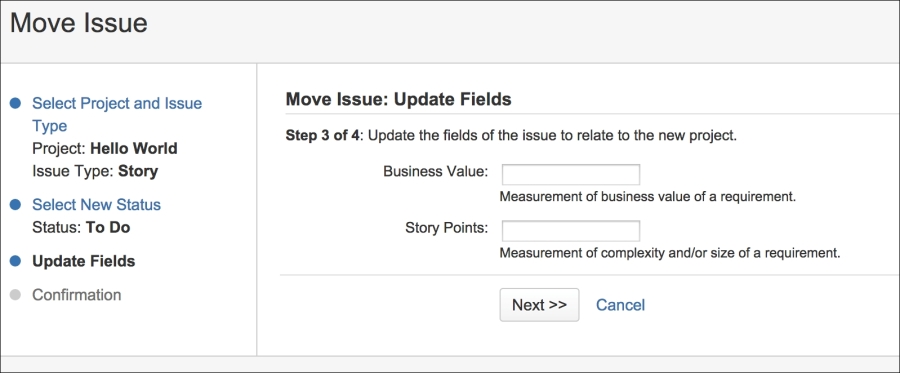
The fourth and last step shows you the summary of the changes that will be applied, by moving the issue from project A to project B. This is your last chance to make sure that all the information is correct. If there are any mistakes, you can go back to step one and start over again. If you are happy with the changes, confirm the move by clicking on Move.

Once the issue is moved, it will be given a new issue key based on the new project. However, JIRA is still able to redirect you if you access the issue with its old issue key.
The most straightforward way to express your interest in a JIRA issue is to vote for it. For organizations or teams that manage their priorities based on popularity, voting is a great mechanism to collect this information. The Popular Issues project tab mentioned in Chapter 2, Project Management will display all the voted issues.
An example of this is how Atlassian uses JIRA (for example, https://jira.atlassian.com/browse/JRA-9) as a way to let its customers choose and vote for the features they want to be implemented or bugs to be fixed, by voting on issues based on their needs. This allows the product management and marketing team to have an insight on the market needs and how to best evolve their offerings.
One thing to keep in mind is when voting, you can only vote ONCE per issue. You can vote many times for many different issues, but for any given issue, you have only one vote. This helps prevent a single user from continuously voting on the same issue, which may blow the final statistics out of proportion. You can, however, unvote a vote you have already cast on an issue, and vote for it again later; if you choose to do this, it will still only count as one vote.
To vote for an issue, simply click on the Vote for this issue link next to Votes. When you have voted for an issue, the icon will appear as colored. When you have not yet voted for an issue, the icon will appear gray. Note that you cannot vote for issues you have created.
JIRA is able to send automated e-mail notifications about updates on issues to users. Normally, notification e-mails will only be sent out to the issue's reporter, assignee, and people who have registered interest in the issue. This behavior can be changed through Notification Schemes, which we will discuss in Chapter 7, E-mails and Notifications.
You can register your interest in the issue by choosing to watch the issue. By watching an issue, you will receive e-mail notifications on activity updates. Users watching the issue can also choose to stop watching, thus stop receiving e-mail updates from JIRA. You can also add other users as watchers by adding them to the watcher's list.
To watch an issue, simply click on the Start watching this issue link. When you are already watching the issue, the text will be Stop watching this issue. If you click on the link again, you will stop watching the issue, as shown in the following screenshot:
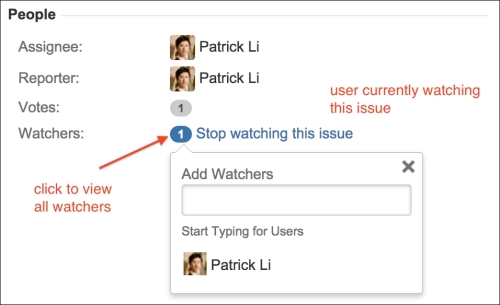
JIRA also shows how many people are actively watching the issue by displaying the total watchers next to the watch icon. You can click on the number next to Watchers to see the full list of watchers.
Once an issue has been created, the user normally assigned to the issue will start working on it. Afterwards, the user can assign the issue further, for example, to QA staff for further verification.
There are many instances where an issue needs to be reassigned to a different user. For example, the current assignee may be unavailable, or if issues are created with no specific assignees. Another example will be that issues are assigned to different people at different stages of the workflow. For this reason, JIRA allows users to reassign issues once they have been created.
Perform the following steps to assign an issue:
- Browse to the issue you wish to assign.
- Click on the Assign button in the Issue menu bar or press A on your keyboard (you can also use the in-line edit feature here). This will bring up the Assign dialog.
- Select the new assignee for the issue, and optionally add a comment to provide some information to the new assignee.
- Click on the Assign button.
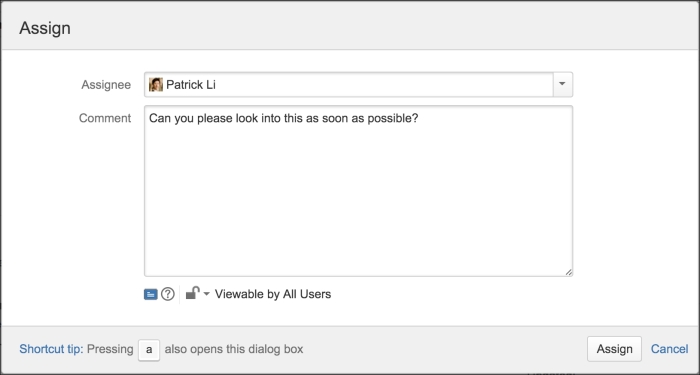
Once this issue has been reassigned, its assignee value will be updated to the new user. The new assignee will also receive a notification e-mail, alerting him/her of the assignment. You can also un-assign an issue this way by simply selecting the Unassigned option. Unassigned issues do not have an assignee and will not show up on anyone's list of active issues.
If you want to e-mail an issue to other users in JIRA, instead of having to manually copy and paste the issue's URL in an e-mail, you can use the built-in share feature in JIRA. All you have to do is go to the issue you want to share, click on the share icon or press S on your keyboard as shown in the following screenshot. Then select the users you want to share the issue with and click the Share button.
